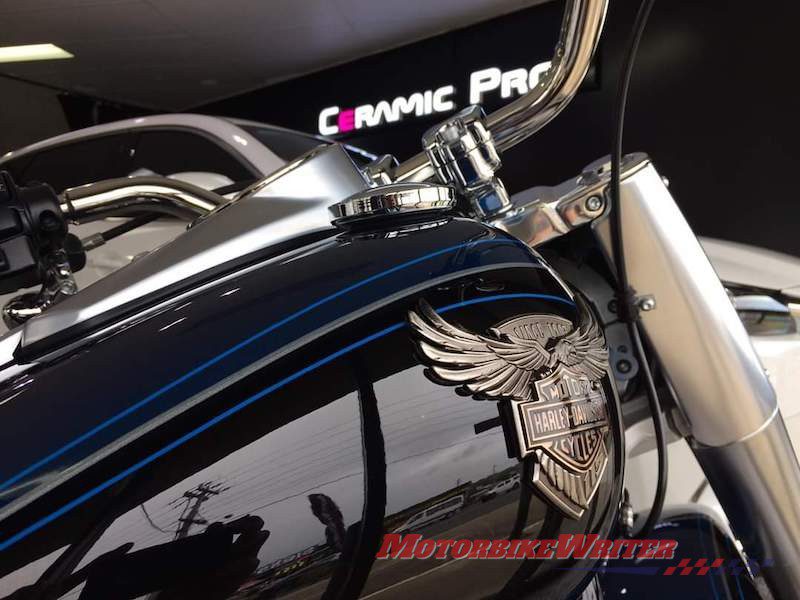Let Loose the Prospective of Your Bike With Ceramic Coating: a Comprehensive Step-By-Step Guide

Advantages of Ceramic Covering
Enhancing the durability and appearance of your bike, ceramic covering gives a protective layer that drives away dirt and pollutants, making maintenance much easier and extending the life expectancy of the automobile. This innovative layer creates a semi-permanent bond with the surface area of the motorcycle, developing a hydrophobic barrier that prevents water spots, oxidation, and UV damages. By minimizing the attachment of dirt and gunk, ceramic coating not just maintains your bike looking immaculate however additionally lessens the need for regular cleans and outlining.
Additionally, the chemical resistance of ceramic covering guards the motorcycle's paint from ecological toxins and severe chemicals, such as bird droppings and tree sap, that can trigger etching and staining. This protective layer likewise offers UV security, protecting against the paint from fading or discolouring gradually because of sunlight exposure. Eventually, spending in ceramic covering for your bike not only boosts its aesthetic charm yet likewise streamlines upkeep regimens and maintains its problem for years ahead.
Required Devices and Products
What important tools and materials are required for applying ceramic covering to your bike? To effectively use ceramic finishing to your motorcycle, you will certainly need a set of crucial devices and products.
Other necessary tools consist of applicator pads or towels for spreading out the ceramic finish, covering up tape to secure delicate locations from accidental application, and handwear covers to keep your hands clean throughout the procedure. It is also advised to have some isopropyl alcohol accessible for cleaning the surface area of the motorcycle before using the ceramic covering. Last but not least, having a well-ventilated work area or functioning outdoors is vital to ensure correct ventilation while applying the ceramic finish to your motorbike.

Preparing Your Motorbike Surface
Before applying ceramic layer to your bike, thorough surface area prep work is important to ensure ideal bond and durability of the covering. Start by cleaning your bike with a pH-neutral shampoo to get rid of dirt, oil, and pollutants. Utilize a microfiber cloth to dry out the surface completely. Next off, examine the paint for any blemishes such as scratches, swirl marks, or oxidation. Address these concerns by polishing or worsening the impacted locations.
After fixing any kind of imperfections, utilize an alcohol-based paint cleaner to more cleanse the surface area and YOURURL.com remove any type of company website remaining residues. This action is vital as it makes sure a clean canvas for the ceramic finishing to bond efficiently. As soon as the surface is smooth and clean, make use of a paint prep or surface area preparation product to remove any kind of remaining oils or deposits that can hinder the bonding process.
Using Ceramic Coating
Having carefully prepared the surface of your motorcycle, the next essential action is the specific application of ceramic finish to make sure enduring security and a glossy surface. Shake the ceramic covering bottle well prior to usage to ensure an uniform uniformity.
When applied, permit the coating to heal for the advised time as per the maker's directions. For ideal results, stay clear of revealing the motorbike to water or other elements for at the very least 24 hours to enable the ceramic covering to fully treat and bond to the surface area.
Maintenance Tips for Longevity

Inspecting your bike regularly for any signs of damages to the ceramic coating, such as scratches or chips, and addressing them without delay can help keep the honesty of the finishing. Using a ceramic coating booster or spray sealant every couple of months can likewise help invigorate the finish and provide added defense versus ecological aspects.
Last but not least, keeping your bike in a garage or covered location when not in usage can shield it from long term direct exposure to sunshine, rainfall, and other harmful aspects that can use down the ceramic layer - motorcycle ceramic coating. By adhering to these upkeep suggestions, article source you can guarantee that your bike's ceramic coating stays reliable and sturdy for an extensive duration
Final Thought
To conclude, ceramic layer can substantially enhance the appearance and security of your motorcycle. By adhering to the essential steps laid out in this overview, you can let loose the full possibility of your bike and ensure its longevity. Proper prep work, application, and upkeep are key to optimizing the benefits of ceramic covering. Buy the necessary tools and products, and enjoy the lasting results of a well-protected bike surface.
It is additionally advised to have some isopropyl alcohol on hand for cleaning the surface area of the motorbike prior to using the ceramic coating. motorcycle ceramic coating. Having a well-ventilated office or functioning outdoors is crucial to make certain appropriate ventilation while applying the ceramic coating to your motorbike
Prior to applying ceramic coating to your motorcycle, thorough surface area prep work is vital to make sure optimum bond and long life of the finish.Having actually carefully prepared the surface of your motorcycle, the next essential action is the specific application of ceramic finish to make sure lasting protection and a glossy surface. For optimal outcomes, prevent exposing the bike to water or various other components for at the very least 24 hours to enable the ceramic layer to totally heal and bond to the surface area.